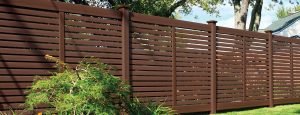How much does a Vinyl Fence really cost? You’re not alone if you’re wondering about the expenses involved. At Utah Fencing Company, we understand that grasping the cost factors can be confusing. We’re here to break everything down for you, providing the insights you need to make an informed decision about your fencing project. If you’re a homeowner looking to enhance your property, keep reading to uncover the true costs of a Vinyl Fence.
Factors That Affect Vinyl Fence Costs
Several components impact the overall cost of a Vinyl fence, and understanding these can help you better plan your budget. These key factors include the material quality, fence height, and Installation labor.
The type and quality of the vinyl material you choose affect the cost significantly. Higher quality vinyl is more durable and resistant to weather conditions, but it might come at a higher price point. Cheaper vinyl options might be less reliable in the long run.
Another critical factor is the height of your fence. Taller fences require more materials and, consequently, increase the project cost. Additionally, if you choose a custom design or specific color, these can also contribute to higher expenses.
Material Costs
Material costs for vinyl fencing vary depending on quality and style. To give you a rough estimate, vinyl fencing generally costs between $20 to $40 per linear foot.
Premium-grade vinyl tends to be at the higher end of this spectrum, while the more economical options can save you some money upfront. However, consider the long-term benefits: investing in higher quality can save you maintenance costs in the future.
The style of the fence also influences the material costs. Traditional picket and privacy fences are typically less expensive than more intricate designs, like lattice or ornamental styles.
Labor Costs
Labor costs are another significant component of vinyl fence installation. This can vary depending on the complexity of your project and local labor rates.
For a straightforward vinyl fence with easy access to the installation area, you might be looking at about $30 to $50 per hour for labor. If the project involves obstacles or requires additional grading and preparation, these factors can increase labor costs.
Don’t forget to account for post-installation services such as cleanup and inspection, especially if you want a seamless experience and a perfect final product.
Additional Costs to Consider
Beyond materials and labor, there are other potential costs you might encounter. These can add up quickly if not planned for in advance.
For instance, permits and zoning fees are often required, depending on local regulations. Checking with your local government can help you understand these potential costs upfront.
Other expenses include potential repairs or maintenance tools you might need if any issues arise. While vinyl fences are relatively low-maintenance, no material is entirely maintenance-free.
Cost Comparison: Vinyl vs. Other Fencing Materials
It’s helpful to know how vinyl fencing stacks up against other popular options in terms of cost and benefits. Here’s a quick comparison.
While Wood fences can be less expensive initially, they often require more upkeep and can deteriorate faster than vinyl. Metal fences, such as Aluminum or iron, may provide durability but typically cost more per linear foot than vinyl.
With the low-maintenance and long-lasting benefits of vinyl, many homeowners find it to be a cost-effective and durable fencing option in the long run.
How to Budget for Your Vinyl Fence
Planning your budget for a vinyl fence involves more than just tallying up materials and labor costs. You need a comprehensive approach.
Begin by obtaining quotes from multiple contractors. This will help you understand the range of labor costs in your area and allow you to make an informed decision.
Additionally, set aside a contingency budget. This helps cover any unexpected expenses that might arise during the project, ensuring that you’re financially prepared.
Tips to Save Money on Vinyl Fencing
While fencing can be a significant investment, some strategies can help reduce costs without sacrificing quality.
- Buy in bulk: Purchasing materials in bulk can sometimes lead to discounts.
- DIY installation: If you’re handy, consider doing some or all of the installation yourself.
- Shop around: Compare quotes from various suppliers and contractors to get the best deal.
- Seasonal discounts: Look for promotions or sales during off-peak times of the year.
- Simple designs: Opt for straightforward styles instead of customized options to save on material costs.
Benefits of Choosing Vinyl Fencing
Now that you understand the costs, let’s talk about why you might choose vinyl fencing in the first place. What makes it a superior choice for many homeowners?
Vinyl fences are incredibly durable. They can withstand various weather conditions without rotting, warping, or rusting, which makes them an excellent long-term investment.
Furthermore, vinyl fencing requires minimal maintenance. A simple wash every once in a while is usually enough to keep it looking new, saving you time and money on upkeep.
Common Myths About Vinyl Fencing Costs
There are plenty of misconceptions about vinyl fencing costs that we’d like to clarify.
One common myth is that vinyl fences are always more expensive than wood. While the initial cost might be higher for vinyl, the low maintenance and longevity often make it more cost-effective over time.
Another myth is that all vinyl is the same. The quality of vinyl can vary significantly, and investing in higher-grade materials can offer better durability and overall value.
Conclusion
Vinyl fences are an attractive, durable, and cost-effective option for many homeowners. By understanding the various factors that influence the cost, you can make an educated decision that suits your budget and needs. For a detailed estimate tailored to your specific project, contact Utah Fencing Company today.
Reach out to us by phone # 801-905-8153 or Request a Free Quote.




